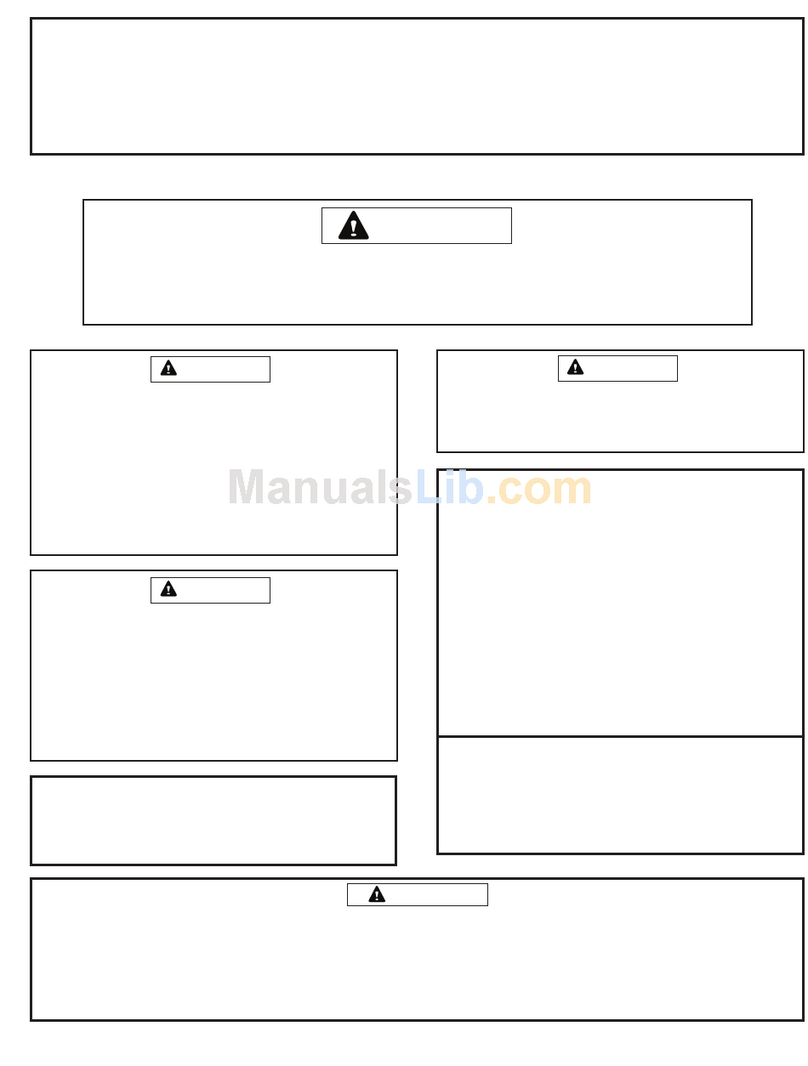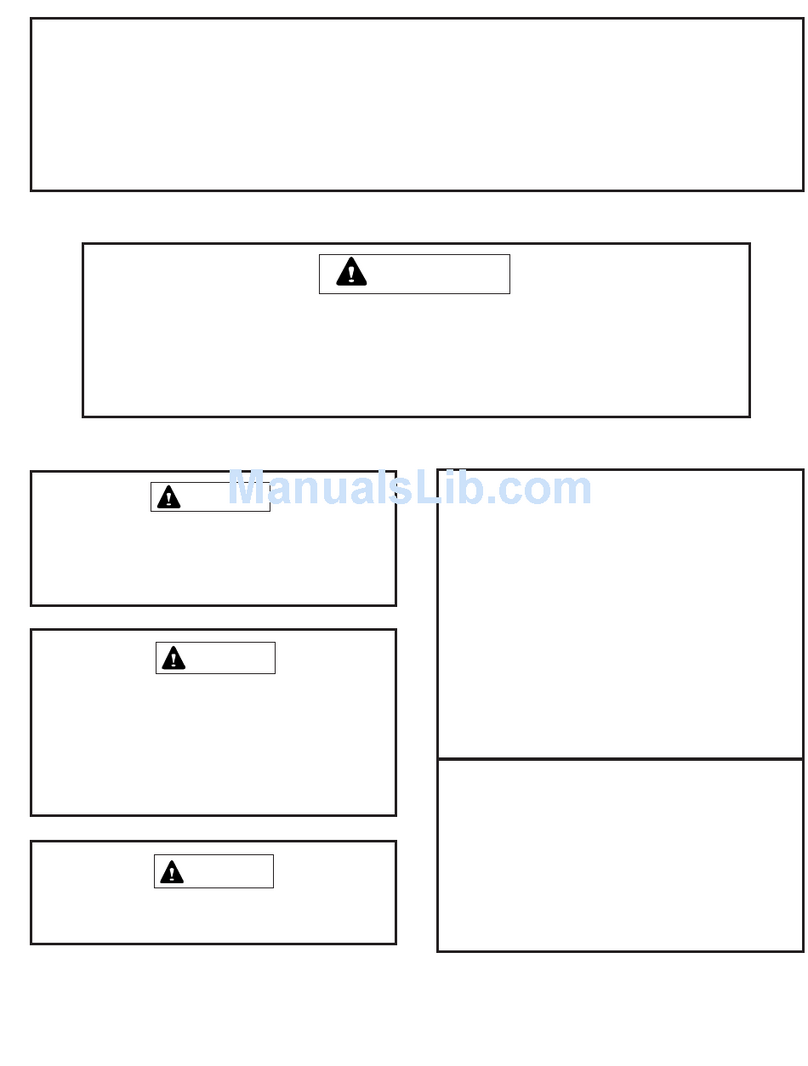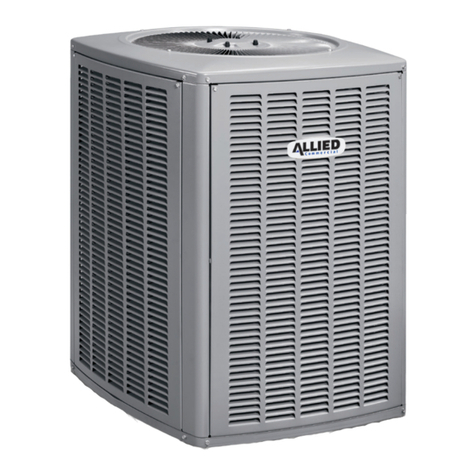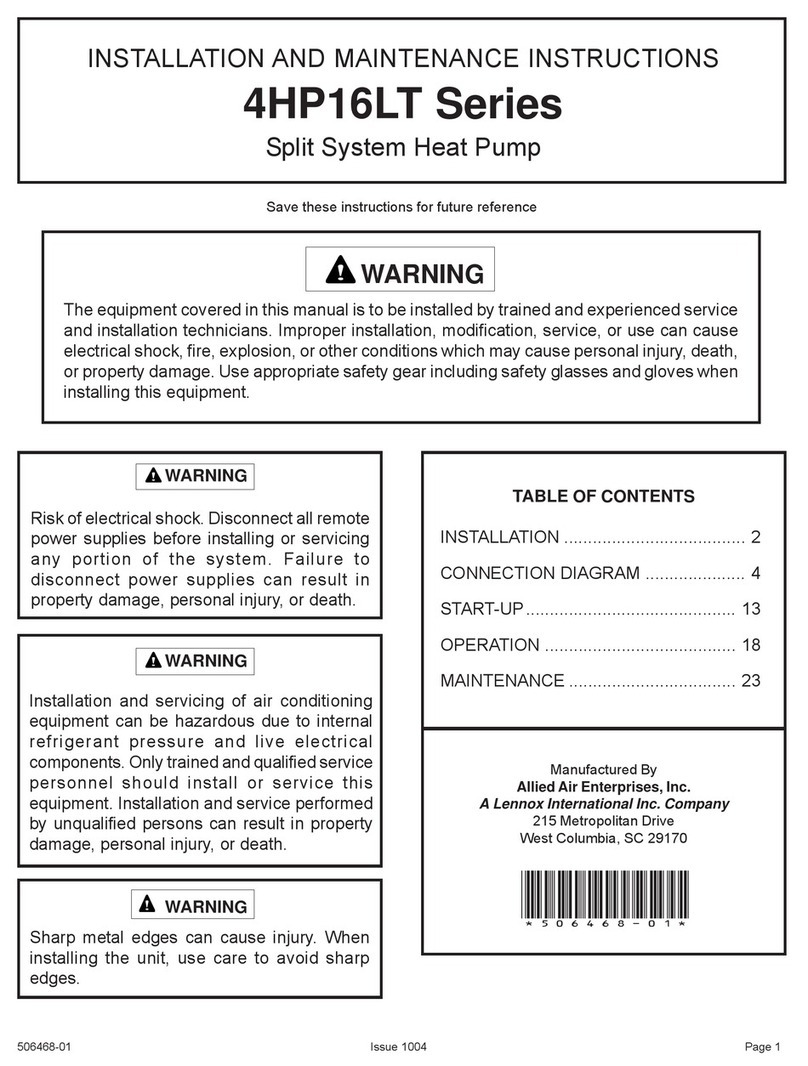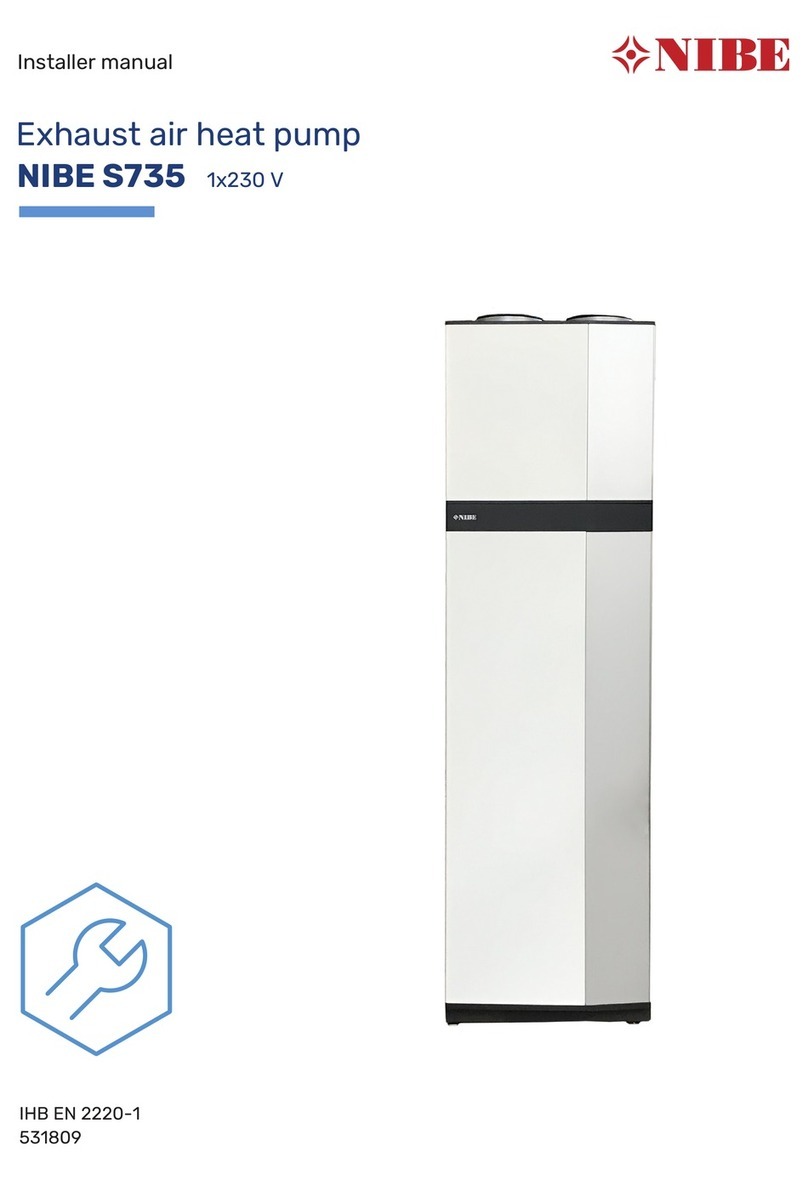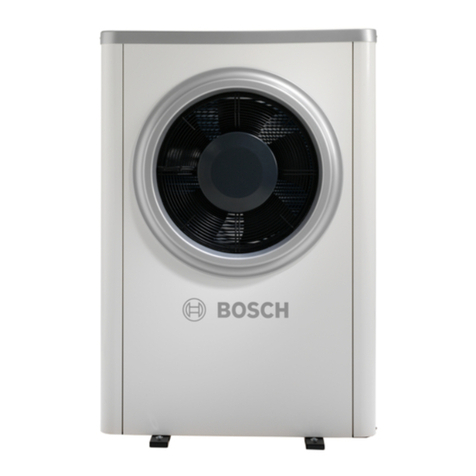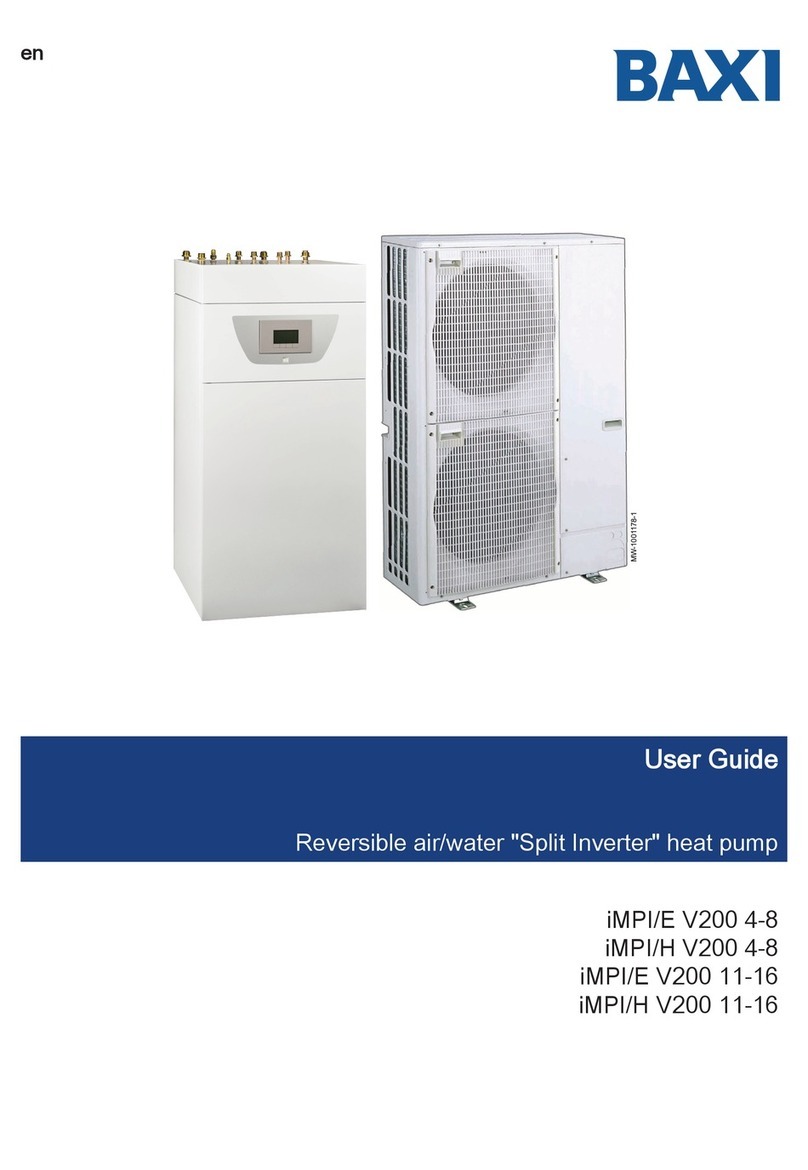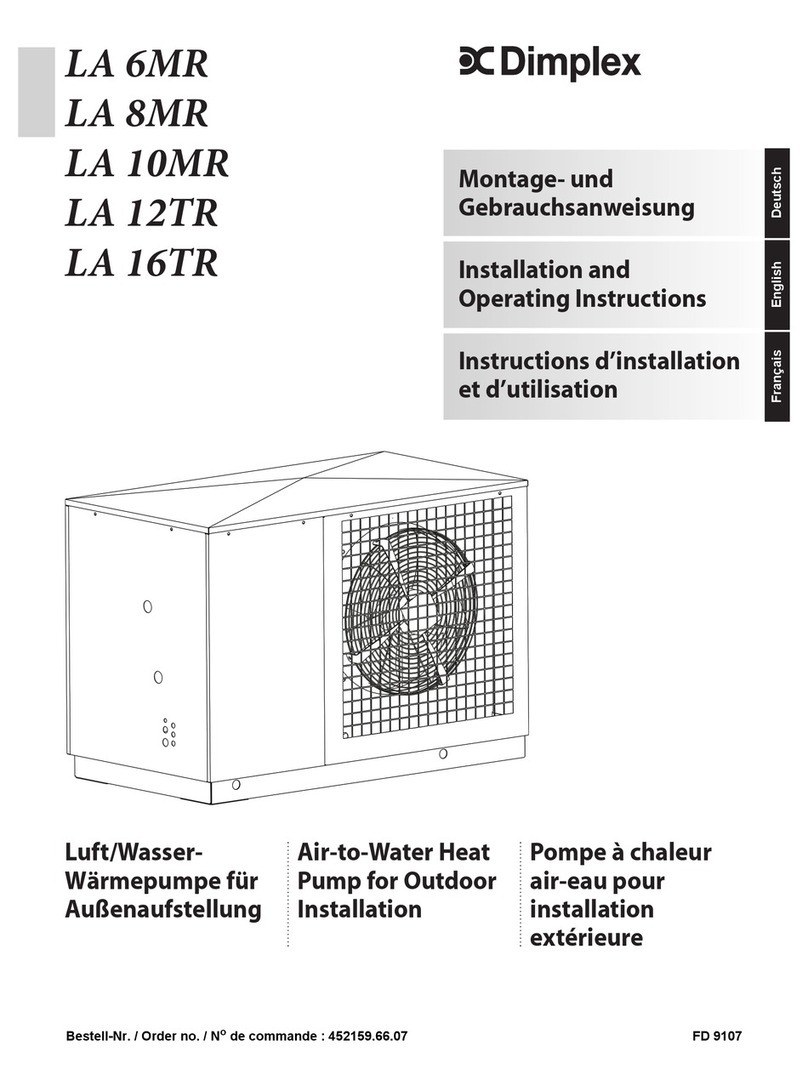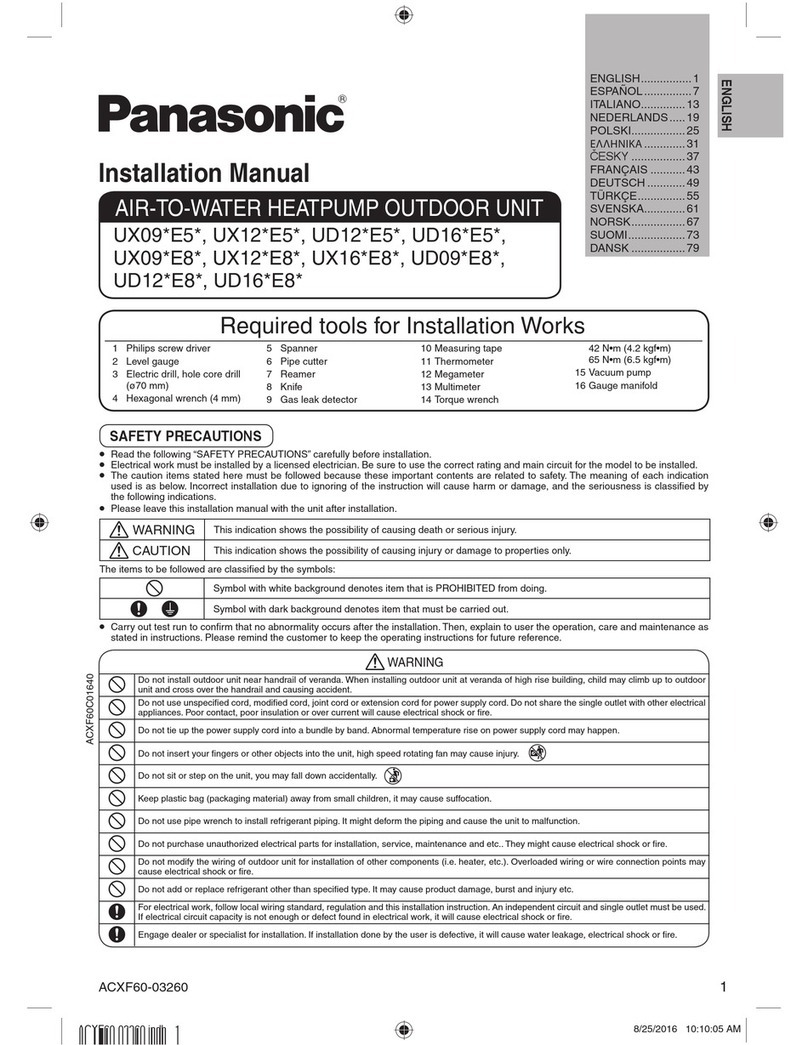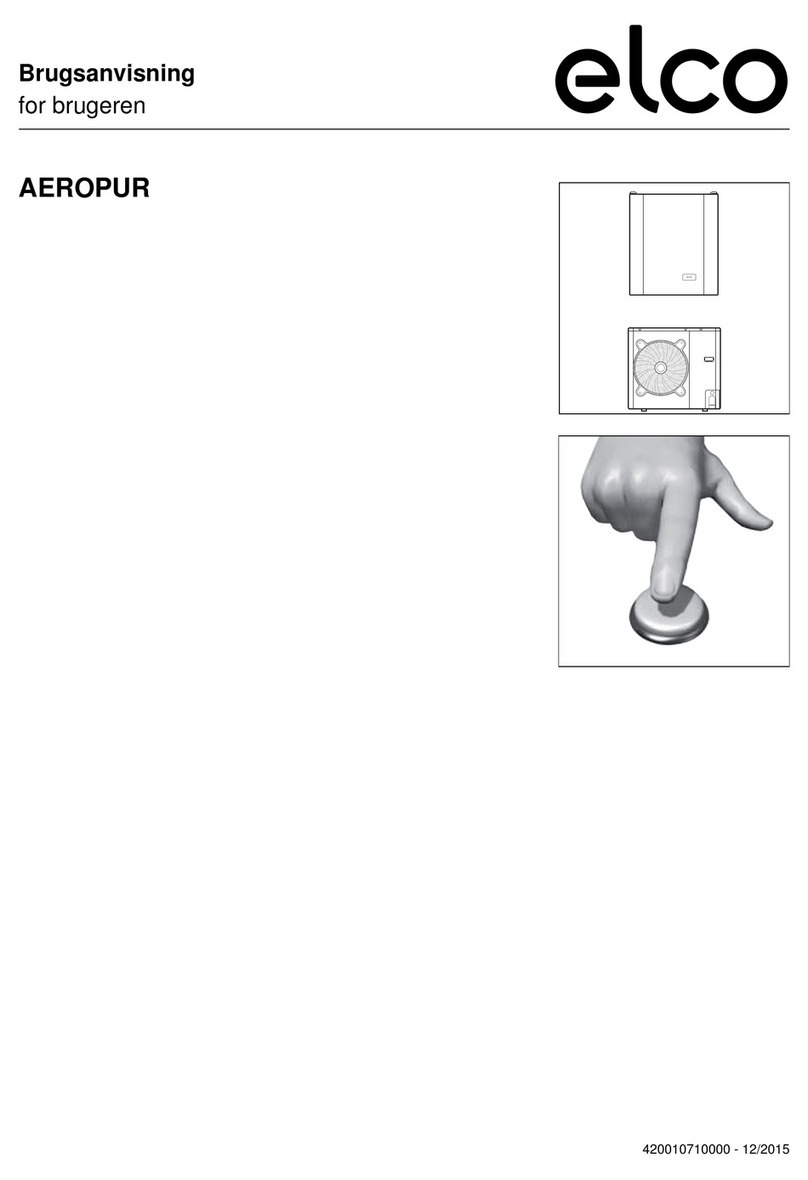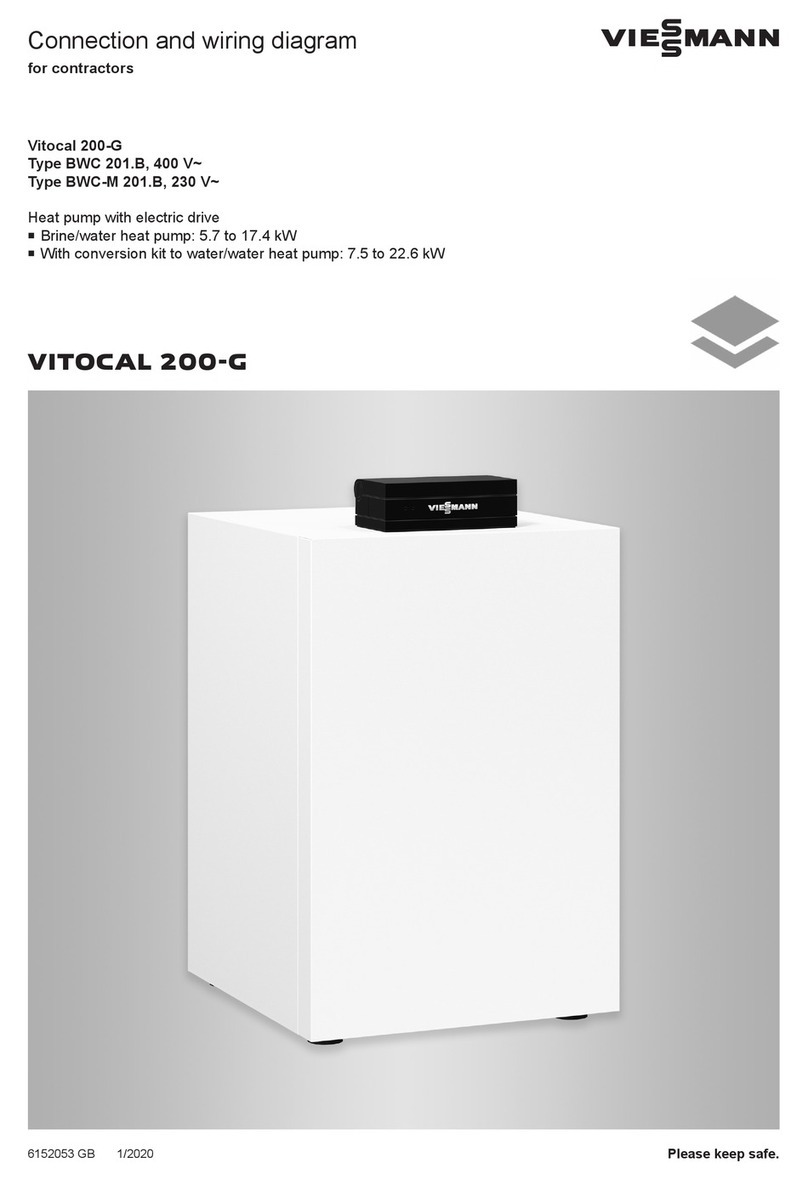Allied Air 2HP13 User manual

100402-07 Issue 0733 Page 1 of 18
These instructions must be read and understood completely before attempting installation.
Issue 0733
SafetyPrecautions ...................................... 2
UnitLocation&Installation................................ 2
Rooftop Installation & Recommendations .................... 3
Indoor Coil Piston Selection ............................... 3
RefrigerationLineSets................................... 3
InstallationofLineSets .................................. 4
Leak Check ........................................... 4
Evacuating&Charging................................... 4
Opening Service Valve ................................... 5
Electrical Connections ................................... 5
ControlWiring.......................................... 5
Start-Up Procedure ...................................... 6
Adjustingcharge........................................ 6
DefrostSystem......................................... 7
SinglePhaseWiringDiagram ............................. 9
3PhaseWiringDiagram ................................. 10
Homeowner'sInformation................................. 15
Warranty.............................................. 17
Installation or repairs made by unqualified persons can result in hazards to you and others. Installation
MUST conform with local building codes and with the National Electrical Code NFPA 70/ANSI C1-1993 or
current edition and Canadian Electrical Code Part 1 CSA C22.1.
2HP13 & 2HP14 SPLIT SYSTEM HEAT PUMP
INSTALLATION / START-UP INSTRUCTIONS
/HOMEOWNERS INFORMATION MANUAL
TABLE OF CONTENTS
These units are designed for use in residential and light commercial type buildings. Heat Pumps may only be
installed with indoor combinations listed in the Air-Conditioning and Refrigeration Institute (ARI) Directory of
Certified Products. Refer to http://www.aridirectory.org/index.html .
Inspect the unit for any damage before installation. If damage is found, notify the transportation company
immediately and file a concealed damage claim.
Improper installation, adjustment, alteration, service or maintenance will void the warranty. The qualified installer or
agency must usefactory-authorized kits oraccessories when added tothisproducts. Refer tothe individualinstructions
included with the specific accessory kit.
NOTE
These instructions are intended as a general guide and do not supersede national, state or local codes in any way.
These instructions must be left with the property owner.

100402-07 Issue 0733 Page 2 of 18
Safety Precautions
Followall safetycodes. Wearsafetyglassesandwork
gloves. Use quenching cloth for brazing operations. Have
fire extinguisher available. Read these instructions
thoroughly and follow all warning or cautions attached to
the unit.
1. Always wear proper personal protection equipment.
2. Always disconnect electrical power before removing
panel or servicing equipment.
3. Keep hands and clothing away from moving parts.
4. Handle refrigerant with caution, refer to proper MSDS
from refrigerant supplier.
5. Use care when lifting, avoid contact with sharp edges.
UNIT LOCATION & INSTALLATION
NOTE: In some cases noise in the living area has been
traced to gas pulsations from improper installation
of equipment.
1. Locate unit away form windows, patios, decks, etc.
where unit operation sounds may disturb customer.
2. Ensure that vapor and liquid tube diameters are
appropriate to capacity of unit.
3. Run refrigerant tubes as directly as possible by
avoiding unnecessary turns and bends.
4. Leave some slack between structure and unit to
absorb vibration.
5. When passing refrigerant tubes through the wall, seal
opening with RTV or other silicon-based caulk.
6. Avoiddirecttubingcontactwithwaterpipes,duct work,
floor joists, wall studs, floors, walls, and any structure.
7. Donotsuspendrefrigeranttubingfromjoistsand studs
with a rigid wire or strap which comes in direct contact
with tubing.
8. Ensure that tubing insulation is pliable and completely
surrounds vapor tube.
When outdoor unit is connected to factory-approved
indoorunit,outdoorunitcontainssystemrefrigerantcharge
for operation with indoor unit of the same size when
connectedby 15ft. offield-supplied tubing. Forproper unit
operation, check refrigerant charge using charging
information located on control box cover.
IMPORTANT: Maximumliquid-linesize is3/8in.O.D.for
all residential applications including long
lines.
Outdoor Section
Zoning ordinances may govern the minimum distance
the condensing unit can be installed from the property line.
Install on a Solid, Level Mounting Pad
The outdoor section is to be installed on a solid
foundation. This foundation should extend a minimum of
2" (inches) beyond the sides of the outdoor section. To
reducethe possibilityofnoisetransmission,the foundation
slab should NOT be in contact with or be an integral part of
the building foundation.
This product and/or the indoor unit that is
matched with may contain fiberglass wool.
Disturbing the insulation during installation,
maintenance, or repair will expose you to
fiberglasswooldust. (Fiberglasswoolisknown
to the State of California to cause cancer.)
Fiberglass wool may also cause respiratory,
skin, and eye irritation.
To reduce exposure to this substance or for
further information, consult material safety data
sheets available from your distributor.
NOTE TO INSTALLING DEALER
Theseinstructionsandwarrantyareto be given
to the owner or displayed near the indoor air
handler unit.
Beforeinstalling,modifying,orservicingsystem,
mainelectricaldisconnectswitchmustbe in the
OFF position. There may be more than 1
disconnectswitch. Lockout andtagswitchwith
a suitable warning label. Electrical shock can
cause personal injury or death.

100402-07 Issue 0733 Page 3 of 18
Elevate Unit
Elevateunitperlocalclimateandcoderequirementsto
provide clearance above estimated snowfall level and
ensure adequate drainage of unit. Use snow stand in
areas where prolonged freezing temperatures are
encountered.
Ifconditions orlocal codesrequire theunitbe attached
to pad or mounting frame, tie down bolts should be used
andfastenedthroughknockoutsprovidedinunitbase pan.
Roof Top Installations
Mount on level platform or frame 6 inches above roof
surface. Place unit above a load-bearing wall and isolate
unit and tubing set from structure. Arrange supporting
members to adequately support unit and minimize
transmission of vibration to building. Ensure roof structure
and anchoring method is adequate for location. Consult
local codes governing rooftop applications.
Roof mounted units exposed to winds above 5 mph
may require wind baffles to achieve adequate defrost. A
sheet metal baffle should be spaced 6-1/2" from the fall of
the coil. The height should cover the face of the coil and
the length should be 6" from the access panel.
NOTE: Unit must be level to within ± 2/(± 3/8 in./ft) per
compressor manufacturer specifications.
Clearance Requirements
When installing, allow sufficient space for airflow
clearance, wiring, refrigerant piping, and service. For
proper airflow, quiet operation and maximum efficiency.
Position so water, snow, or ice from roof or eaves cannot
fall directly on unit.
DO LOCATE THE UNIT:
!With proper clearances on sides and top of unit
!On a solid, level foundation or pad
!To minimize refrigerant line lengths
DO NOT LOCATE THE UNIT:
!On brick, concrete blocks or unstable surfaces
!Near clothes dryer exhaust vents
!Near sleeping area or near windows
!Under eaves where water, snow or ice can fall
directly on the unit
!with clearance less than 2 ft. from a second unit
!with clearance less than 4 ft. on top of unit
Operating Ambient
The minimum outdoor operating ambient in cooling
modeis55/F,andthemaximumoutdooroperatingambient
incoolingmodeis125/F. Themaximumoutdooroperating
ambient in heating mode is 66/F.
Indoor Coil Piston Selection
The outdoor heat pump section must be matched to a
factory approved indoor section. It is mandatory that the
installer ensure that the correct piston is installed in the
indoorsection. Ifnecessaryremovetheexistingpistonand
replace it with the correct piston See indoor unit
instructions for details of changing the piston. Contact
your distributor for accessory piston kits.
Indoor (Cooling) Piston Size
Theevaporator coil mayuseanexpansion valve(TXV) in place of piston.
14 SEER Heat Pump Models
All 14 SEER heat pumpmodels are only rated with TXV on
the indoor side.
Refrigeration Line Sets
Use only refrigerant grade copper tubes. Split
systems may be installed with up to 50 feet of line set (no
more than 20 feet vertical) without special consideration
(see long line set guidelines).
Accumulation of water and ice in base pan may
cause equipment damage.
13 SEER Heat Pump Indoor Piston Sizes
Unit Size Piston Size
18 .055
24 .063
30 .068
36 .076
42 .076
48 .082
60 .098
14 SEER Heat Pump Indoor TXV
Unit Size TXV Kit
18 thru 36 TXV3
42 thru 48 TXV5

100402-07 Issue 0733 Page 4 of 18
Recommended Liquid & Vapor Tube Diameters (In.)
It is important that no tubing be cut or seals broken
until you are ready to actually make connections to the
evaporatorandtothecondensersection. DONOTremove
rubber plugs or copper caps from the tube ends until ready
to make connections at evaporator and condenser. Under
no circumstances leave the lines open to the atmosphere
for any period of time, if so unit requires additional
evacuation to remove moisture.
Be extra careful with sharp bends. Tubing can "kink"
very easily, and if this occurs, the entire tube length will
have to be replaced. Extra care at this time will eliminate
future service problems.
It is recommended that vertical suction risers not be
up-sized. Proper oil return to the compressor should be
maintained with suction gas velocity.
Installation of Line Sets
DO NOT fasten liquid or suction lines in direct contact
with the floor or ceiling joist. Use an insulated or
suspension type of hanger. Keep both lines separate, and
always insulate the suction line. Long liquid line runs (30
feet or more) in an attic will require insulation. Route
refrigeration line sets to minimize length.
DONOTletrefrigerantlinescomeindirectcontactwith
foundation. When running refrigerant lines through the
foundation or wall, openings should allow for a sound and
vibration absorbing material to be placed or installed
between tubing and foundation. Any gap between
foundationorwall andrefrigerant lines shouldbe filled with
a vibration damping material.
Beforemakingbrazeconnections,besurealljointsare
clean. Before heat is applied for brazing, dry nitrogen
should be flowing through the tubing to prevent oxidation
and scale formation on the inside of the tubing.
The following is the recommended method for making
braze connections at the refrigerant line connections:
1. Debur and clean refrigerant tube end with emery
cloth or steel brush.
2. Insert tubing into swage fitting connection.
3. Wrap wet rags over valves to protect from heat.
4. Allow dry nitrogen to flow through refrigerant lines.
5. Braze joint, using a suitable brazing alloy for copper
to copper joints.
6. Quench the joint and tubing with water using a wet
rag. Leave rag on fitting body and re-wet with water
to help cool area.
Leak Check
Refrigeration lines and indoor coil must be checked for
leaks after brazing and before evacuation. The
recommended procedure is to apply a trace amount of
vapor refrigerant (approximately two ounces or 3 psig) into
the line set and indoor coil, then pressurize with 150 psig
of dry nitrogen. Use a refrigerant leak detector to check all
joints. The system may also be checked for leaks using a
halide torch or pressure and soapy solution. After
completion of leak check, relieve all pressure from system
before evacuation.
Evacuating And Charging Instructions
NOTE: Intentional release of CFC or HCFC refrigerant
totheatmosphere violates Federal Law. Itmay
also violate State and Local Codes. Check all
Federal, State and Local Codes before
proceeding.
These outdoor units are pre-charged at the factory with
adequaterefrigeranttohandle15 feetofrefrigeranttubing.
NOTE: DO NOT use any portion of the charge for purging
or leak testing. It is mandatory that a thorough
evacuationoftherefrigeration linesand indoorcoil
be performed.
The liquid line and suction line service valves have been
closed after final testing at the factory. DO NOT disturb
these valves until the lines have been leak checked and
evacuated or the charge in the unit may be lost.
1. Connect the vacuum pump to the center hose of the
manifoldgaugeset,thelow-pressuremanifoldgauge
to the vapor service valve and the high pressure
manifold gauge to the liquid service valve.
NOTE: Unnecessary switching of hoses can be avoided
and complete evacuation of all lines can be
achieved by also connecting a branch hose from
the manifold gauge center port to a cylinder of R-
22. Provide a separate shut-off valve to vacuum
pump to avoid contaminating vacuum pump oil
with refrigerant.
Unit Size LIQUID VAPOR
Connection Dia. Tube Dia. Connection Dia. Tube Dia.
018 3/8" 3/8" 3/4 3/4
024 3/8" 3/8" 3/4 3/4
030 3/8" 3/8" 3/4 3/4
036 3/8" 3/8" 3/4 3/4
042 3/8" 3/8" 7/8 7/8
048 3/8" 3/8" 7/8 7/8
060 3/8" 3/8" 7/8 *1-1/8
*FIELD SUPPLIED 7/8 X 1-1/8 CONNECTOR REQUIRED ON BOTH
ENDS OF VAPOR TUBING.
If ANY refrigerant tubing is buried, provide a 6 inch
vertical rise at service valve. Refrigerant tubing
lengthsupto 36inchesmaybe buriedwithoutfurther
special consideration. For lengths above 36 inches,
consult your local distributor.

100402-07 Issue 0733 Page 5 of 18
2. The valves should be kept in the "front seated"
(closed) position. This will allow evacuation of the
refrigeration lines and the indoor coil, without
disturbing the factory charge in the outdoor unit.
3. Follow the vacuum pump manufacturer's
instructions. Allow the pump to operate until the
system has been evacuated down to 300 microns.
Allow the pump to continue running for an additional
15 minutes. Turn OFF the pump and leave the
connections secured to the two (2) service valves.
After 5 minutes, if the system fails to hold 500
micronsorless, checkallconnectionsfortightfit and
repeat the evacuation procedure.
4. Isolatethe vacuumpumpfrom thesystemby closing
the shutoff valves on the gauge-set. Disconnect the
vacuum pump.
Opening Service Valves
After evacuation of the connecting lines, remove the
service valve cap and fully insert the hex wrench into the
stem. A back-up wrench is required on the valve body to
open the valve stem. Back-out counterclockwise until the
valve stem just touches the coined edge.
Wrench sizes:
3/8 service valve: 3/16" Hex wrench
3/4 service valve: 5/16" Hex wrench
7/8 service valve: 5/16" Hex wrench
Replaceservicevalvecapandtorqueto8-11ft-lbon3/8"
valves;12-15ft-lbon3/4"valves;15-20ft-lbon7/8"valves.
Use backup wrench on valve body when torqueing valve
cap.
Install Electrical Accessories
Refer to the instructions packaged with the accessories.
Electrical Connections
Besure tocheckall localcodesto determinethat theunit
is installed accordance with local requirements. Consult
the National Electric Code for wire size requirements. Use
60/C wire or higher. Always provide ground connections
to the outdoor unit. Power supply must agree with rating
on unit nameplate.
Provide line voltage power supply to unit from a properly
sized disconnect switch. Route power and ground wires
from disconnect switch to unit. Line voltage connections
are made at the line side of the contactor in the control box
of the outdoor unit. Follow the appropriate wiring diagram
attached to inside of the access panel.
Propercircuitprotectionrecommendationsare indicated
on Unit Rating Plate. Time delay fuses are required to
prevent blowing due to starting current (the current in rush
when equipment starts is referred to as the Locked Rotor
Amps or (LRA). A fuse of this kind properly sized will give
maximum equipment protection.
Use copper wire only between disconnect switch and
unit.
Remove access panel to gain access to unit wiring.
Extend wires from disconnect through power wiring hole
provided and into unit control box. Flexible conduit is
required for the swing out control box feature.
Connectground wiretogroundconnectionin controlbox
for safety. Connect power wiring to contactor.
High voltage power connections to 3-phase models is
made to "Pig Tail" leads with field supplied splice
connectors.
Control Wiring
The control voltage is 24 Vac. NEC Class I insulated 18
AWGis requiredfor controlwiring. For lengths longerthan
150feet, contactyourlocaldistributor fortechnicalservice.
Ensure the room thermostat is properly installed per
instructions shipped with room thermostat. Generally the
thermostat should not be exposed to sunlight, drafts or
vibration and should not be mounted on exterior walls.
Low voltage control wire connections should be made to
the screw connection terminal board mounted on the
defrost control as shown. All low voltage control wiring
must be separated from incoming power leads.
....
ELECTRICAL SHOCK HAZARD!
TurnOFFelectricpowerbeforeconnectingunit,
performing any maintenance or removing
panels or doors. More than one disconnect
may be required to turn off all power.
FAILURE TO DO SO COULD RESULT IN BODILY
INJURY OR DEATH.
The unit cabinet must have an uninterrupted or
unbroken ground to minimize personal injury if
an electrical fault should occur. The ground
may consist of electrical wire or metal conduit
when installed in accordance with existing
electrical codes. Failure to follow this warning
can result in an electric shock, fire, or death.

100402-07 Issue 0733 Page 6 of 18
Heat Pump Application with Electric Heat
Emergency Heat (heating heat pump)
If selector switch on thermostat is set to the emergency
heat position, the heat pump will be locked out of the
heating circuit, and all heating will be electric heat ( if
applicable). A jumper should be placed between W and E
on the thermostat so that the electric heat control will
transfer to the first stage heat on the thermostat. This will
allow the indoor blower to cycle onand off with the electric
heat when the fan switch is in the AUTO position.
* Add Jumper on Subbase (Optional)
Start-Up Procedure
1. Check to ensure:
!Servicevalveandgage portcapsareinstalled and
tightened.
!Voltage supply at unit agrees with nameplate
rating.
!Field wiring connections are tight and factory
wiring has not been disturbed and are tight.
!Indoor fan motor is on correct speed tap.
2. Set thermostat selector switch to OFF and fan control
switch to "Auto" is so equipped.
3. Close electrical disconnects to energize system.
4. Set room thermostat at desired temperature. Be sure
set point is below indoor ambient temperature.
5. Set the system switch of the thermostat on COOL (or
HEAT if applicable) and fan switch for continuous
operation (ON) or AUTO, as desired. There will be a
5 minute short cycle compressor delay on startup.
Operate unit for 15-20 minutes, then check the system
refrigerant charge.
6. Adjust refrigerant charge per "Adjusting Charge"
section.
Adjusting Charge
Factory charge is shown on the rating label located on
the access panel.
All split system heat pumps are factory charged for
15 feet of connecting line set and matched indoor fan
coil. Nameplate refrigerant charge should initially be
adjusted for line set lengths other than 15 feet. For line
setsshorter than15feet inlength,removecharge. Forline
sets longer than 15 feet, add charge. Oil charge is
sufficient for all line lengths.
Beforefinaladjustmentismadetotherefrigerantcharge,
it is imperative that proper indoor airflow be established.
Airflow will be higher across a dry coil versus a wet coil.
Blower charts are calculated with a dry or wet coil basis.
Recommended airflow is 350-450 CFM per ton (12,000
Btuh) through a wet coil. Refer to indoor unit instructions
for methods of determining air flow and blower
performance.
Cooling Cycle Charge Adjustment
The optimum method for checking the charge is by
weight. However the following methods may be used
to confirm the proper charge:
Units with Indoor Pistons
Units installed with indoor pistons require charging with
the superheat method.
The following procedure is valid when indoor airflow is
within ± 20% of its rated CFM.
1. Operate unit a minimum of 10 minutes before
checking charge.
2. Measure suction pressure by attaching a gage to
suction valve service port. Do not use compressor
suction port. Determine saturation temp from T/P
chart.
3. Measure suction temperature by attaching an
accurate thermistor type or electronic thermometer
to suction line at service valve.
4. Calculate superheat (measured temp. — saturation
temp.).
5. Measure outdoor air dry-bulb temperature with
thermometer.
6. Measure indoor air (entering indoor coil) wet-bulb
temperature with a sling psychrometer.
7. Comparesuperheatreadingatservicevalvewiththe
chart located on control box cover.
8. If unit has a higher suction line temperature than
charted temperature, add refrigerant until charted
temperature is reached.
9. If unit has a lower suction line temperature than
chartedtemperature,reclaimrefrigerantuntilcharted
temperature is reached.
Refrigeration Charge Adjustment
Liquid Line Diameter Oz. Per Linear Foot *
3/8" .6
* Factory charge for series is for 15' (ft.) line sets and matched fan
coil.

100402-07 Issue 0733 Page 7 of 18
10. Remove charge if superheat is low and add charge
if superheat is high.
Units with Indoor TXV
Units installed with TXV on indoor side, require charging
with the subcooling method.
1. Operate unit a minimum of 10 minutes before
checking charge.
2. Measure liquid service valve pressure by attaching
an accurate gage to service port. Determine
saturation temp. from T/P chart.
3. Measure liquid line temperature by attaching an
accurate thermistor type or electronic thermometer
to liquid line near outdoor coil.
4. Calculate subcooling (saturation temp.— measured
temp.).
5. Find the point where required subcooling
temperatureintersectsmeasuredliquidservicevalve
pressure.
6. Add refrigerant if subcooling is lower than table
below. Recover refrigerant if subcooling is high.
Heating Check Chart Procedure
To check system operation during heating cycle, refer to
the Heating Check Chart located on back of control box
cover. This chart indicates whether a correct relationship
exists between system operating pressure and air
temperature entering indoor and outdoorunits. If pressure
and temperature do not match on chart, system refrigerant
charge may not be correct. Do not use chart to adjust
refrigerant charge.
Charge must be rechecked again during the cooling
season.
Cold Weather Application
A cold weather accessory kit may be required for heat
pumps operating at ambient conditions below 25/F.
Supplementalheatshouldbeprovidedfortheseconditions
due to the expected performance degeneration.
SYSTEM OPERATION
The outdoor unit and indoor blower cycle on demand
from the room thermostat. When the thermostat blower
switch is in the ON position, the indoor blower operates
continuously.
Filter Drier
The outdoor unit is equipped with a bi-flow filter drier. If
replacementisnecessary,ordernewdryeraccordingtothe
service parts manual.
Emergency Heat Function (Room Thermostat)
An emergency heat function is designed into some room
thermostats. This feature is applicable when isolation of
outdoor unit is required or when auxiliary electric heat is
stagedbyoutdoorthermostats. Whentheroomthermostat
is placed in the emergency heat position, the outdoor unit
control circuit is isolated from power and field-provided
relays bypass the outdoor thermostats. An amber
indicating light simultaneously comes on to remind the
homeowner that he is operating in the emergency heat
mode.
Emergency heat is usually used during an outdoor unit
shutdown, but it should also be used following a power
outage. If power has been off for over an hour and the
outdoor temperature is below 50/F (10/C). System should
be left in the emergency heat mode at least six hours to
allow the crankcase heater sufficient time to prevent
compressor slugging. This applies only to systems with
crank case heaters.
Defrost System
The defrost system includes two (2) components: a
defrost thermostat and a defrost control.
Defrost Thermostat
The defrost thermostat is located on the liquid line
between the check/expansion valve and the distributor.
When defrost thermostat senses 29/F or cooler, the
thermostat contacts close and send a signal to the defrost
control board to start the defrost timing. It also terminates
defrost when the liquid line warms up to 60/F.
Defrost Control
The defrost control board includes the combined
functions of a time/temperature defrost control, defrost
relay, diagnostic LEDs and terminal strip for field wiring
connections.
The control provides automatic switching from normal
heating operation to defrost mode and back. During
compressor cycle, the control accumulates compressor
run times at 30-, 60-, or 90-minute field-adjustable
intervals. If the defrost thermostat is closed when the
selected compressor run time interval ends (call for
Model Required Subcooling
(± I/F)
HP 13 HP 14
18 14 10
24 9 3
30 13 8
36 9 14
42 11 3
48 8 9
60 12 -

100402-07 Issue 0733 Page 8 of 18
defrost), the defrost relay is energized and defrost begins.
The factory setting is 60 minutes. However, if frost
accumulation is easily cleared, the optimum efficiency
setting is 90 minutes.
Outdoor Unit Defrost Control Board
Defrost Control Timing Pins
Each timing pin selection provides a different
accumulated compressor run time period for one defrost
cycle. This time period must occur before a defrost cycle
isinitiated. Thedefrostintervalcanbeadjusted to30(/T1),
60 (T2), or 90 (T3) minutes. The defrost timing jumper is
factory-installed to provided a 90-minute defrost interval.
If the timing selector jumper is not in place the control
defaults to a 90-minute defrost interval. The maximum
defrost period is 14 minutes and cannot be adjusted.
A TEST option is provided for troubleshooting. The
TEST mode may be started any time the unit is in the
heating mode and the defrost thermostat is closed or
jumpered. If the jumper is in the TEST position at power-
up, the control will ignore the test pins. When the jumper
is placed across the TEST pins for 2 seconds, the control
will enter the defrost mode. If the jumper is removed
before an additional 5 second period has elapsed ( 7
seconds total), the unit will remain indefrost mode until the
defrost thermostat opens or 14 minutes have passed. If
the jumper is not removed until after the additional 5
second period has elapsed, the defrost will terminate and
the test option will not function again until the jumper is
removed and re-applied.
Compressor Delay
The defrost board has a field-selectable function to
reduce occasional sounds that may occur while the unit is
cyclinginandoutofthe defrostmode. Thecompressorwill
be cycled "off" for 30 seconds going in and out of the
defrost mode when the compressor delay jumper is
removed.
NOTE: The 30 second "off" cycle is not functional when
jumpering the TEST pins.
Time Delay
The timed-off delay is 5 minutes long. The delay help to
protect the compressor from short-cycling in case the
power to the unit is interrupted or a pressure switch opens.
The delay is bypassed by placing the timer select jumper
across the TEST pins for 0.5 seconds.
Pressure Switch Circuit
The defrost control incorporates 2 pressure switch
circuits. Theoptionalhigh pressureswitch connects tothe
boardsHI PSterminals. The lowpressureswitch isfactory
installed.
Duringasingledemandcycle,thedefrostcontrolwilllock
out the unit after the fifth time that the circuit is interrupted
by any pressure switch wired to the control board. In
addition, the diagnostic LEDs will indicate a locked-out
pressure switch after the fifth occurrence of an open
pressureswitch. Theunitwillremainlockedoutuntilpower
to the board is interrupted, then re-established or until the
jumper is applied to the TEST pins for 0.5 seconds.
NOTE: The defrost control board ignores input from the
low-pressure switch terminals as follows:
!During the TEST mode,
!During the defrost cycle,
!During the 90 second start-up period,
!and for the first 90 seconds each time the reversing
valve switches heat/cool modes. If the TEST pins
are jumpered and the 5 minute delay is being by-
passed, the LO PS terminal signal is not ignored
during the 90 second start-up period.
Diagnostic LEDS
The defrost board uses 2 LEDs for diagnostics. The
LEDs flash a specific sequence according to the condition.
Defrost Control board Diagnostic LED
Mode Green LED (DS2) Red LED (DS1)
No power to control OFF OFF
Normal operation/
power to control Simultaneous Slow FLASH
Anti-short cycle
lockout Alternating Slow FLASH
Low pressure switch
fault (Optional) OFF Slow FLASH
Low pressure switch
lockout (Optional) OFF ON
High pressure switch
fault (Optional) Slow FLASH OFF
High pressure Switch
lockout (Optional) ON OFF

100402-07 Issue 0733 Page 9 of 18
H/P SINGLE PHASE WIRING DIAGRAM

100402-07 Issue 0733 Page 10 of 18
H/P 3 PHASE WIRING DIAGRAM

100402-07 Issue 0733 Page 11 of 18
SUPERHEAT TABLES FOR CHARGING SYSTEMS WITH PISTON COILS
Required Superheat for 2HP13 (B,L)18P-1A
Heating Mode Pressures 2HP13(B,L)18P-1A
Required Superheat for 2HP13 (B,L)24P-1A
Heating Mode Pressures 2HP13(B,L)24P-1A
INDOOR
WET-BULB (/F) OUTDOOR DRY BULB TEMPERATURE (/F)
60 65 70 75 80 85 90 95 100 105 110 115
53 6 -- -- -- -- -- -- -- -- -- -- --
55 9 1 -- -- -- -- -- -- -- -- -- --
57 12 4 -- -- -- -- -- -- -- -- -- --
59 15 8 1 -- -- -- -- -- -- -- -- --
61 18 12 6 1 -- -- -- -- -- -- -- --
63 18 15 12 9 3 -- -- -- -- -- -- --
65 24 20 16 12 6 3 -- -- -- -- -- --
67 27 24 20 17 13 10 6 3 -- -- -- --
69 30 28 25 23 19 13 7 5 -- -- -- --
71 34 32 30 28 26 16 8 7 3 -- -- --
73 37 36 35 34 32 27 22 15 10 -- -- --
75 40 40 39 39 39 38 37 36 34 32 31 30
OUTDOOR
(/F) Press. (psig) OUTDOOR
(/F) Press. (psig)
High Low High Low
70 234 85 30 168 42
65 225 79 25 161 38
60 216 73 20 154 33
55 208 69 15 148 30
50 199 63 10 142 25
45 190 57
40 183 53
35 176 47
INDOOR
WET-BULB (/F) OUTDOOR DRY BULB TEMPERATURE (/F)
60 65 70 75 80 85 90 95 100 105 110 115
53 6 -- -- -- -- -- -- -- -- -- -- --
55 9 1 -- -- -- -- -- -- -- -- -- --
57 13 5 -- -- -- -- -- -- -- -- -- --
59 17 9 1 -- -- -- -- -- -- -- -- --
61 20 13 6 0 -- -- -- -- -- -- -- --
63 20 17 13 10 3 -- -- -- -- -- -- --
65 27 22 17 13 6 3 -- -- -- -- -- --
67 30 26 22 18 15 11 7 3 -- -- -- --
69 33 30 28 25 21 13 7 5 -- -- -- --
71 37 35 33 31 29 19 10 7 3 -- -- --
73 40 39 38 37 36 32 27 21 10 -- -- --
75 43 43 43 43 44 44 44 45 45 46 46 47
OUTDOOR
(/F) Press. (psig) OUTDOOR
(/F) Press. (psig)
High Low High Low
70 228 73 30 164 36
65 220 68 25 156 32
60 211 63 20 150 28
55 202 59 15 144 26
50 194 54 10 139 22
45 185 49
40 178 45
35 171 40

100402-07 Issue 0733 Page 12 of 18
Required Superheat for 2HP13 (B,L)30P-1A
Heating Mode Pressures 2HP13(B,L)30P-1A
Required Superheat for 2HP13 (B,L)36P-1A
Heating Mode Pressures 2HP13(B,L)36P-1A
INDOOR
WET-BULB (/F) OUTDOOR DRY BULB TEMPERATURE (/F)
60 65 70 75 80 85 90 95 100 105 110 115
53 6 -- -- -- -- -- -- -- -- -- -- --
55 9 1 -- -- -- -- -- -- -- -- -- --
57 9 3 -- -- -- -- -- -- -- -- -- --
59 11 6 2 -- -- -- -- -- -- -- -- --
61 14 10 5 1 -- -- -- -- -- -- -- --
63 15 12 10 8 3 -- -- -- -- -- -- --
65 19 16 13 10 5 3 -- -- -- -- -- --
67 22 19 16 14 11 8 6 3 -- -- -- --
69 25 22 20 18 15 13 7 5 -- -- -- --
71 27 26 24 22 20 12 5 7 3 -- -- --
73 30 29 28 27 25 20 15 7 10 -- -- --
75 33 32 31 31 30 28 26 23 18 13 11 8
OUTDOOR
(/F) Press. (psig) OUTDOOR
(/F) Press. (psig)
High Low High Low
70 252 84 30 181 42
65 243 78 25 173 37
60 233 73 20 160 33
55 224 68 15 159 30
50 214 62 10 153 25
45 205 57
40 197 52
35 189 46
INDOOR
WET-BULB (/F) OUTDOOR DRY BULB TEMPERATURE (/F)
60 65 70 75 80 85 90 95 100 105 110 115
53 6 -- -- -- -- -- -- -- -- -- -- --
55 9 1 -- -- -- -- -- -- -- -- -- --
57 12 4 -- -- -- -- -- -- -- -- -- --
59 15 8 1 -- -- -- -- -- -- -- -- --
61 18 12 6 1 -- -- -- -- -- -- -- --
63 18 15 12 9 3 -- -- -- -- -- -- --
65 24 20 16 12 6 3 -- -- -- -- -- --
67 27 24 20 17 13 10 6 3 -- -- -- --
69 30 28 25 23 19 13 7 5 -- -- -- --
71 34 32 30 28 26 16 8 7 3 -- -- --
73 37 36 35 34 32 27 22 15 10 -- -- --
75 40 40 39 39 39 38 37 36 34 32 31 30
OUTDOOR
(/F) Press. (psig) OUTDOOR
(/F) Press. (psig)
High Low High Low
70 269 84 30 193 42
65 259 78 25 185 37
60 248 73 20 177 33
55 239 68 15 170 30
50 228 62 10 163 25
45 219 57
40 210 52
35 202 46

100402-07 Issue 0733 Page 13 of 18
Required Superheat for 2HP13 (B,L)42P-1A
Heating Mode Pressures 2HP13(B,L)42P-1A
Required Superheat for 2HP13 (B,L)48P-1A
Heating Mode Pressures 2HP13(B,L)48P-1A
INDOOR
WET-BULB (/F) OUTDOOR DRY BULB TEMPERATURE (/F)
60 65 70 75 80 85 90 95 100 105 110 115
53 6 -- -- -- -- -- -- -- -- -- -- --
55 9 1 -- -- -- -- -- -- -- -- -- --
57 12 4 -- -- -- -- -- -- -- -- -- --
59 15 8 1 -- -- -- -- -- -- -- -- --
61 18 12 6 1 -- -- -- -- -- -- -- --
63 18 15 12 9 3 -- -- -- -- -- -- --
65 24 20 16 12 6 3 -- -- -- -- -- --
67 27 24 20 17 13 10 6 3 -- -- -- --
69 30 28 25 23 19 13 7 5 -- -- -- --
71 34 32 30 28 26 16 8 7 3 -- -- --
73 37 36 35 34 32 27 22 15 10 -- -- --
75 40 40 39 39 39 38 37 36 34 32 31 30
OUTDOOR
(/F) Press. (psig) OUTDOOR
(/F) Press. (psig)
High Low High Low
70 266 87 30 192 43
65 257 81 25 183 39
60 246 75 20 176 34
55 237 70 15 168 31
50 226 65 10 162 26
45 217 59
40 208 54
35 200 48
INDOOR
WET-BULB (/F) OUTDOOR DRY BULB TEMPERATURE (/F)
60 65 70 75 80 85 90 95 100 105 110 115
53 6 -- -- -- -- -- -- -- -- -- -- --
55 9 1 -- -- -- -- -- -- -- -- -- --
57 15 5 -- -- -- -- -- -- -- -- -- --
59 19 10 1 -- -- -- -- -- -- -- -- --
61 22 14 7 0 -- -- -- -- -- -- -- --
63 22 18 14 10 3 -- -- -- -- -- -- --
65 29 24 18 13 6 3 -- -- -- -- -- --
67 33 28 24 20 16 11 7 3 -- -- -- --
69 36 33 30 27 23 13 7 5 -- -- -- --
71 40 38 36 34 32 22 14 7 3 -- -- --
73 43 42 42 41 40 37 33 29 10 -- -- --
75 47 47 48 48 48 50 52 55 59 64 65 68
OUTDOOR
(/F) Press. (psig) OUTDOOR
(/F) Press. (psig)
High Low High Low
70 281 84 30 202 42
65 271 78 25 193 37
60 260 73 20 185 33
55 250 68 15 178 30
50 239 62 10 171 25
45 229 57
40 220 52
35 211 46

100402-07 Issue 0733 Page 14 of 18
Required Superheat for 2HP13 (B,L)60P-1A
Heating Mode Pressures 2HP13(B,L)60P-1A
.........................
INDOOR
WET-BULB (/F) OUTDOOR DRY BULB TEMPERATURE (/F)
60 65 70 75 80 85 90 95 100 105 110 115
53 6 -- -- -- -- -- -- -- -- -- -- --
55 9 1 -- -- -- -- -- -- -- -- -- --
57 12 4 -- -- -- -- -- -- -- -- -- --
59 15 8 1 -- -- -- -- -- -- -- -- --
61 18 12 6 1 -- -- -- -- -- -- -- --
63 18 15 12 9 3 -- -- -- -- -- -- --
65 24 20 16 12 6 3 -- -- -- -- -- --
67 27 24 20 17 13 10 6 3 -- -- -- --
69 30 28 25 23 19 13 7 5 -- -- -- --
71 34 32 30 28 26 16 8 7 3 -- -- --
73 37 36 35 34 32 27 22 15 10 -- -- --
75 40 40 39 39 39 38 37 36 34 32 31 30
OUTDOOR
(/F) Press. (psig) OUTDOOR
(/F) Press. (psig)
High Low High Low
70 292 74 30 210 37
65 281 69 25 200 33
60 270 64 20 192 29
55 259 60 15 184 26
50 248 55 10 177 22
45 237 50
40 228 46
35 219 41

100402-07 Issue 0733 Page 15 of 18
Homeowner's Information
Heat Pump Operation
Yournewheatpumphasseveral characteristicsthat you
should be aware of:
!Heat pumps satisfy heating demand by delivering
largeamounts ofwarm airintothe livingspace. This
is quite different from gas-or oil-fired furnaces or an
electric furnace which deliver lower volumes of
considerably hotter air to heat the space.
!Do Not be alarmed if you notice frost on the outdoor
coil in the winter months. Frost develops on the
outdoor coil during the heating cycle when
temperatures are below 45/F. An electronic control
activates a defrost cycle lasting 5 to 15 minutes at
preset intervals to clear the outdoor coil of the frost.
!Duringthedefrostcycle,youmaynoticesteamrising
from the outdoor unit. This is a normal occurrence.
Thethermostatmayengageauxiliaryheatduringthe
defrost cycle to satisfy a heating demand; however.,
theunit willruntonormaloperation attheconclusion
of the defrost cycle.
In case of extended power outage...
If the outdoor temperature is below 50/F and power to
your outdoor unit has been interrupted for 6 hours or
longer,observethe followingwhen restoring powerto your
heat pump system.
!Set the room thermostat selector to the "Emergency
Heat"settingtoobtaintemporaryheatforaminimum
of 6 hours. This will allow system refrigerant
pressuresandtemperaturesenoughtimetoreturnto
a stabilized condition.
!In Emergency Heat mode, all heating demand is
satisfied by auxiliary heat; heat pump operation is
locked out. After a 6 hour "warm-up" period, the
thermostatcanthenbeswitchedtothe"Heat"setting
and normal heat pump operation my resume.
!Heat pumps (in the cooling mode) remove humidity
from your home. Depending on the amount of
moistureintheair insideyourhome,waterwill trickle
from the condensate drain of the cooling coil.
Thermostat Operation
The wall-mounted thermostat controls your air
conditioner. The thermostat is available in various
configurations from different manufacturers. The
informationbelow istypicalfor mostthermostats. Askyour
dealer for specific information regarding the model of
thermostat installed.
Temperature Setting Levers
Mostheatpumpthermostatshave2temperatureselector
levers: one for heating and one for cooling. Set the levers
or dials to the desired temperature set points for both
heating and cooling. Avoid frequent temperature
adjustment; turning the unit off and back on before
pressures equalize puts stress on the unit compressor.
On heat pump systems, increasing your thermostat
setting by more than 2 degrees may cause supplemental
heaters to turn on, reducing potential energy savings.
Fan Switch
InAUTOor INT(intermittent)mode,thebloweroperates
only when the thermostat calls for heating or cooling. This
mode is generally preferred when humidity control is a
priority. The ON or CONT mode provides continuous
indoor blower operation, regardless of whether the
compressor or auxiliary heat are operating. This mode is
requiredwhenconstantaircirculationorfilteringisdesired.
System Switch
Set the system switch for heating, cooling or auto
operation. The auto mode allows the heat pump to
automaticallyswitch fromheating modeto coolingmode to
maintainpredeterminedcomfortsettings. Manyheatpump
thermostats are also equipped with an emergency heat
mode which locks out heat pump operation and provides
temporary heat supplied by the auxiliary heat.
Indicating Light
Most heat pump thermostats have an amber light which
indicates when the heat pump is operating in the
emergency heat mode.
Temperature Indicator
The temperature indicator displays the actual room
temperature.
Fan Control
For fan control your thermostat may have a Fan
SelectionSwitchthatallowsyoutorunthefancontinuously
or cycle it automatically with the heatingor cooling system.
Switch the lever to ON for continuous operation and to
AUTO for automatic cycling.
For maximum comfort satisfaction and continual air
cleaning/filtering, constant fan operation is recommended.
ELECTRICAL SHOCK HAZARD!
Turn OFF electric power to unit before performing
any maintenance or removing panels or doors.
FAILURE TO DO SO COULD RESULT IN BODILY
INJURY OR DEATH.

100402-07 Issue 0733 Page 16 of 18
On models without a fan Selection Switch, the fan will
cycle with the outdoor unit.
Important System Information
!Your system should never be operated without a
clean air filter properly installed.
!Return air and supply air registers should be free
from restrictions or obstructions to allow full flow of
air.
Regular Maintenance Requirements
Yoursystemshould beregularly inspected bya qualified
service technician. These regular visits may include
(among other things) checks for:
!Motor operation
!Ductwork air leaks
!Coil & drainpan cleanliness (indoor & outdoor)
!Electrical component operation & wiring check
!Proper refrigerant level & refrigerant leaks
!Proper airflow
!Drainage of condensate
!Air filter(s) performance
!Blower wheel alignment, balance & cleaning
!Primary & secondary drain line cleanliness
!Proper defrost operation (heat pumps)
There is some routine maintenance procedures you can
do to help keep your system operating at peak
performance between visits.
Air Filter
Inspectair filtersat leastmonthlyand replaceorcleanas
required. Disposablefiltersshouldbereplaced. Washable
filters may be cleaned by soaking in mild detergent and
rinsing with cold water. Replace filters with the arrows
pointing in the direction of airflow. Dirty filters are the most
common cause of poor heating / cooling performance and
compressor failures.
Indoor Coil
If the system has been operated with a clean filter in
place, it should require minimal cleaning. Use a vacuum
cleaner and soft brush attachment to remove any
accumulation of dust from the top and underside of the
finned coil surface. However, perform this maintenance
only when the coil is completely dry.
If the coil cannot be cleaned by this method, call your
dealer for service. It may need a detergent solution and
rinsing with water for cleaning, which may require coil
removal. You should not attempt this yourself.
Condensate Drain
During cooling season check at least monthly for free
flow of drainage and clean if necessary.
Condenser Coils
Grasscuttings,leaves,dirt,dust,lintfromclothes dryers,
andfall offfromtrees canbe drawn intocoils bymovement
ofthe air. Cloggedcondensercoilswilllower theefficiency
of your unit and could cause damage to the condenser.
Periodically, debris should be brushed from the condenser
coils.
Useasoftbristlebrush withlight pressureonly. DONOT
damageorbendcondensercoil fins. Damagedorbentfins
may affect unit operation.
Painted Surfaces
Formaximumprotection oftheunit'sfinish, agoodgrade
of automobile wax should be applied every year. In
geographical areas where water has a high concentration
of minerals (calcium, iron, sulfur, etc.). It is recommended
that lawn sprinklers not be allowed to spray the unit. In
such applications, the sprinklers should be directed away
fromtheunit. Failuretofollow thisprecaution may resultin
premature deterioration of the unit finish and metal
components.
In sea coast areas, special maintenance is required due
to the corrosive atmosphere provided by the high salt
concentrationin oceanmistsand theair. Periodicwashing
of all exposed surfaces and coil will add additional life to
your unit. Please consult your installing dealer for proper
procedures in your geographic area.
1. Ensure thermostat is set below (cooling) or above
(heating) room temperature and that the system lever
is in the "COOL", "HEAT" or "AUTO" position.
2. Inspect your return air filter: If it is dirty your air
conditioner may not function properly.
3. Check indoor and outdoor disconnect switches.
Confirm circuit breakers are ON or that fuses have not
blown. Reset breakers/replace fuses as necessary.
4. Inspect the outdoor unit for clogged condenser coils,
(grass cuttings, leaves, dirt, dust or lint). Ensure that
branches, twigs or other debris are not obstructing the
condenser fan.
IF YOUR SYSTEM STILL DOES NOT OPERATE,
CONTACT YOU SERVICING DEALER.
Be sure to describe the problem, and have the model
and serial numbers of the equipment available.
If warranted replacements parts are required, the
warrantymustbeprocessedthroughaqualifieddistribution
location.
.....
SHARP OBJECT HAZARD!
Condenser coils have sharp edges. Wear adequate
body protection on body extremities (e.g. gloves).
FAILURE TO FOLLOW THIS WARNING COULD
RESULT IN BODILY INJURY.
IF YOUR SYSTEM DOES NOT WORK,
BEFORE REQUESTING A SERVICE CALL:

100402-07 Issue 0733 Page 17 of 18
OUTDOOR EQUIPMENT LIMITED WARRANTY
(Not applicable outside the U.S.A. and Canada.)
Warrantor: Allied Air Enterprises Inc., 215 Metropolitan Drive, West Columbia, SC 29170
These Allied Air Enterprises, Inc. Products are available under the following names: Ducane, Concord
GENERAL FIVE YEAR PART WARRANTY - (hereinafter referred to as the company) warrants the product to be free from
defects in material and workmanship under normal use and maintenance for a period of five (5) years in residential applications (one
(1) year for commercial) on all components, except compressors as noted below. The warranty period begins on the date of original
installation whether or not actual use begins on that date. If the date of original installation cannot be verified, the warranty begins
onthedateofmanufactureplus six(6)months. Atthe Company's sole option,aneworre-manufactured part toreplaceanydefective
part will be provided without charge for the part itself; PROVIDED the defective part is returned to our distributor through a qualified
servicing dealer or contractor. All warranty claims must be processed through a qualified distribution point. The replacement part
assumes the unused portion of the factory warranty. Residential application is defined as a single family or multi-family dwelling.
COVERED PARTS INCLUDE - accumulator, capacitor, condenser coil, contactor, expansions device, fan blade, fan motor,
muffler, reversing valve, service valve, solenoid valve, unit mounted sensors and switches, if present.
COMPRESSOR WARRANTY - The compressor in the above listed product is warranted to be free from defects in material and
workmanship under normal use and maintenance for a period of five (5) years for 13 SEER models (2AC13, 2HP13) and ten (10)
yearsfor 14SEER models(2AC14, 2HP14). Thecompressorwillbeprovided withoutchargeforthecompressor itself;PROVIDED
thedefectivecompressorisreturnedtoourdistributorthroughaqualifiedservicingdealerorcontractor. Thereplacementcompressor
assumes the unused portion of the factory warranty.
THIS WARRANTY DOES NOT INCLUDE LABOR OR OTHER COSTS - incurred for diagnosing, repairing, removing,
installing, shipping, servicing, or handling of either defective parts or replacement parts or complete unit. Other costs not covered
includeitemssuchasanymaterialsnotlistedabove,refrigerantandrefrigerantreclaiming. Suchcostsmaybecoveredbyaseparate
warranty provided by the installing dealer or contractor.
THESE WARRANTIES APPLY ONLY:
-To products in their original installation location and become void upon re-installation.
-TounitsinstalledwithindoorcoilcombinationslistedintheAir-ConditioningandRefrigerationInstitute(ARI)DirectoryofCertified
Unitary Equipment.( http://www.aridirectory.org/index.html )
EXCEPTIONS TO LIMITED WARRANTY - When the outdoor unitis installed in non-residentialapplications; in thesecases the
compressor is warranted for five (5) years.
LIMITATIONS OF WARRANTIES - All implied warranties (including implied warranties of merchantability) are hereby limited in
duration to the period for which the limited warranty is given. Some states do not allow limitations on how long an implied warranty
lasts, so the above may not apply to you. The expressed warranties made in this warranty are exclusive and may not be altered,
enlarged, or changed by any distributor, dealer, contractor or other person whatsoever.
THE COMPANY WILL NOT BE RESPONSIBLE FOR:
1. Failure to start due to voltage conditions, blown fuses, open circuit breakers or other damages due to the inadequacy or
interruption of electrical service;
2. Damage as a result of floods, winds, fires, lightning, accidents, corrosive environments or other conditions beyond the control
of the Company;
3. Damage or repairs required as a consequence of faulty installation, misapplication, abuse, improper servicing, unauthorized
alteration or improper operation;
4. Normal maintenance as outlined in the installation and servicing instructions or owner's manual including coil cleaning, filter
cleaning and/or replacement and lubrication;
5. Parts not supplied or designated by the Company, or damages resulting from their use;
6. The Company products installed outside the United States of America and Canada;
7. Electricity or fuel costs or increases in electricity or fuel costs for any reason whatsoever including additional or unusual use of
supplemental electric heat;
8. ANY SPECIAL INDIRECT OR CONSEQUENTIAL PROPERTY OR COMMERCIAL DAMAGE OF ANY NATURE
WHATSOEVER. Some states do not allow the exclusion of incidental or consequential damages, so the above limitation may
not apply to you.
This warranty gives you specific rights, and you may also have other rights that vary from state to state.

100402-07 Issue 0733 Page 18 of 18
Keepthis book andyoursales sliptogetherfor future reference. Youmust provide proof of purchaseor installation
date for in-warranty service.
Write down the following information about your unit to better help you obtain assistance or service if you ever need it. You
will need to know the complete model and serial number. You can find this information on the unit rating plate.
Dealer Name:
Address:
Phone Number:
Indoor Model Number: Serial Number:
Indoor Model Number: Serial Number:
Installation Date:
This manual suits for next models
1
Table of contents
Other Allied Air Heat Pump manuals
Popular Heat Pump manuals by other brands

NIBE-BIAWAR
NIBE-BIAWAR HK 200S Installation and operating manual

STIEBEL ELTRON
STIEBEL ELTRON WWK 300 A Operating and installation instructions
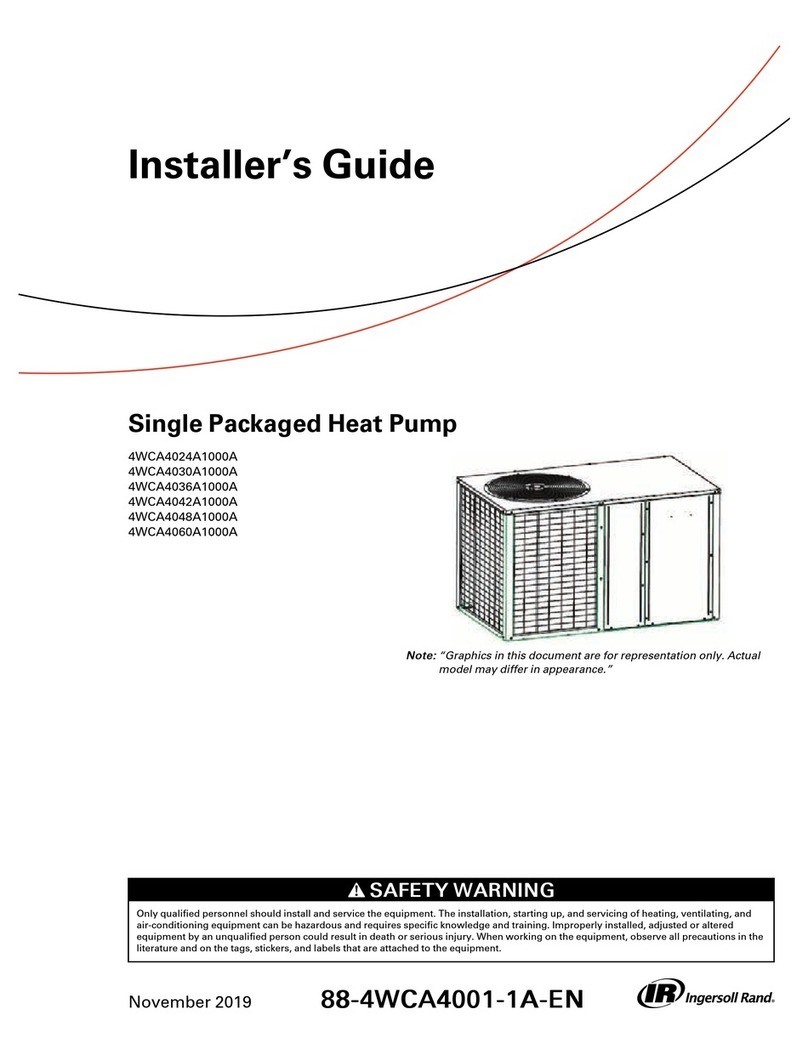
Ingersoll-Rand
Ingersoll-Rand 4WCA4024A1000A Installer's guide

Hitachi
Hitachi YUTAKI S80 Other
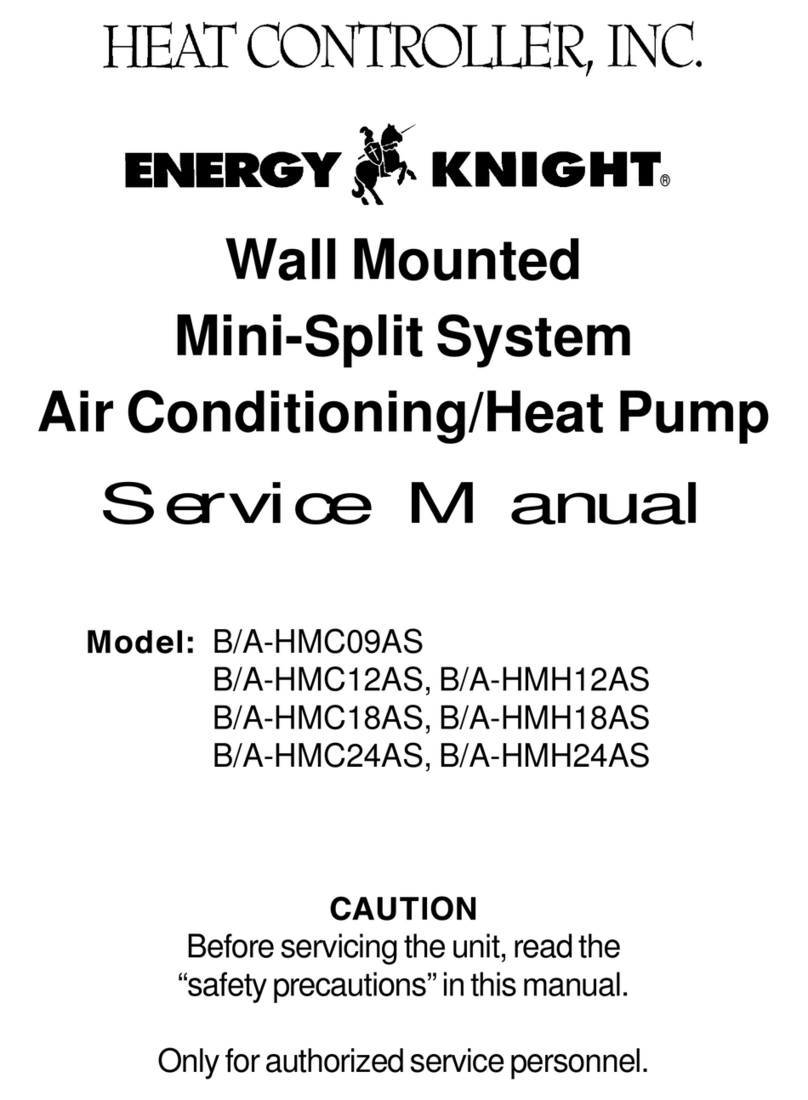
Heat Controller
Heat Controller Energy Knight B/A-HMC09AS Service manual
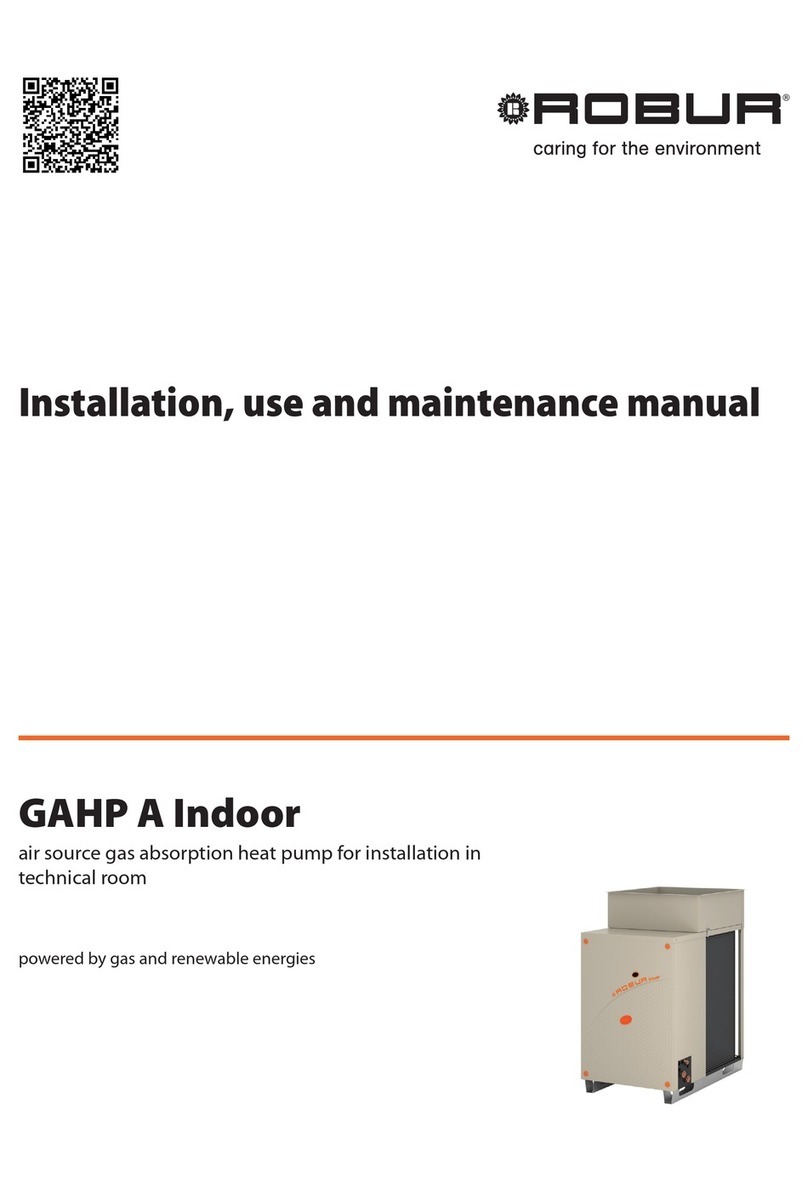
Robur
Robur GAHP A indoor Installation, use & maintenance manual

